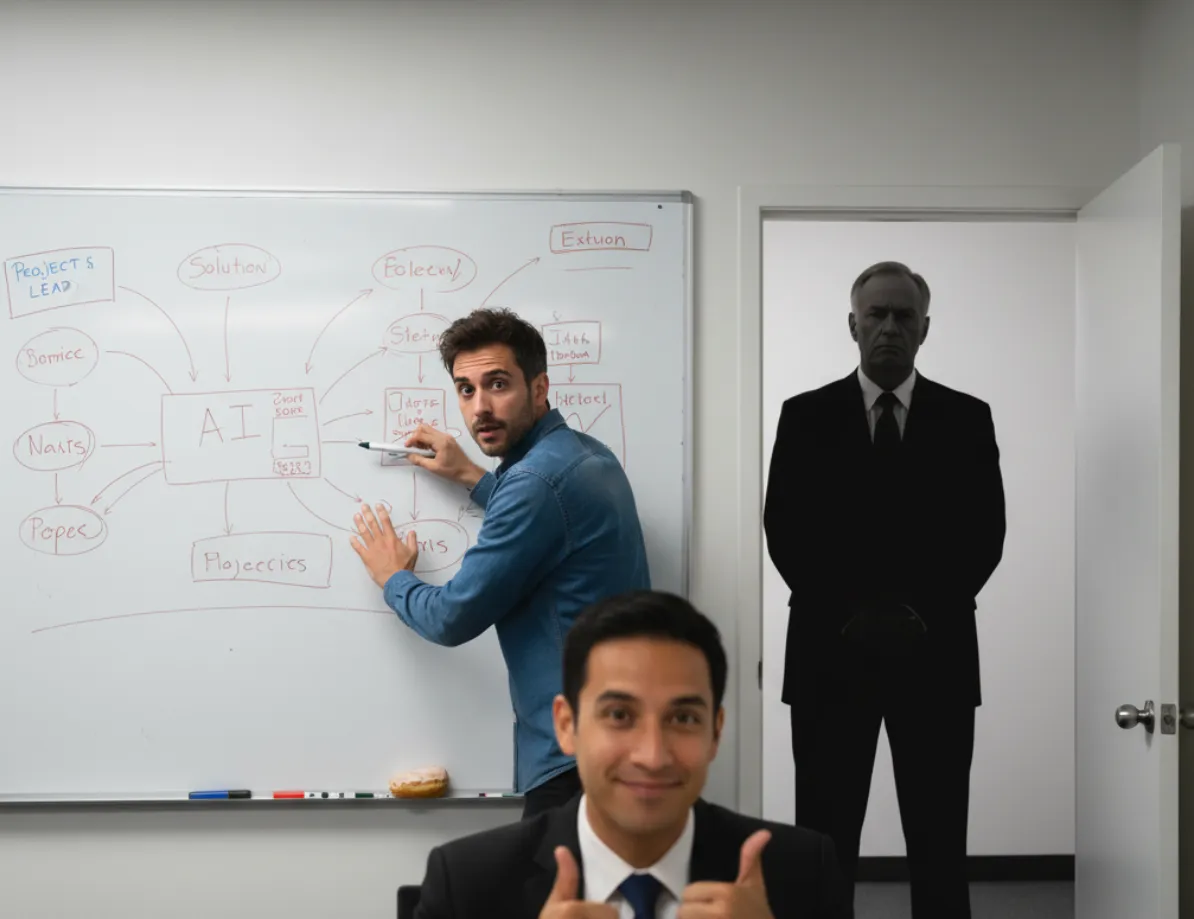· Leadership · 8 min read
A Guide to Selling When Silence is Golden
Struggling with customers who treat their business context like state secrets? You are not alone. In the world of high-stakes tech sales, "it's confidential" is often code for deeper fears about risk, cost, or capability. This post explores creative deal-structuring strategies for the tight-lipped clients. Pivot from selling "business value" to selling against technical KPIs, de-risking "internal initiatives" with phased contracts, and winning over the "we're unique" crowd with managed services.

Disclaimer: The stories, characters, and miraculous deal structures in this post are more “inspired by” true events than a factual recounting of them. Any resemblance to actual persons, living or dead, or to my current employer, is purely coincidental and probably a result of too much caffeine. I’m a salesperson, not a historian – I exaggerate for a living.
A Guide to Selling When Silence is Golden
Alright, fellow revenue warriors and solution architects! Pull up a chair, grab a strong coffee (or something stronger, depending on your last quarter), because we’re about to delve into one of the most intriguing, frustrating, and ultimately rewarding aspects of our craft: the art of selling to the tight-lipped.
You know the drill. You’ve got the latest, greatest tech – an AI marvel, a quantum leap in data processing, a cloud solution so slick it practically moonwalks. You’re ready to unleash a torrent of value propositions, to demonstrate how your widget will supercharge their widgets, boost their bottom line, and probably make their CFO spontaneously break into interpretive dance.
Then, you meet them.
The customers who treat their business context like it’s the launch codes to a secret moon base. The ones who respond to “What’s the business problem you’re trying to solve?” with “That’s… proprietary.” Or, my personal favorite, “It’s an internal initiative.”
Ah, “internal initiative.” The corporate equivalent of a shrug emoji.
Fear not! This isn’t a dead end. This is where the truly creative among us earn our stripes. Because when they won’t share the “why,” we pivot to the “how,” the “what if,” and sometimes, just plain “what the heck.”
The “Black Box” Brigade

Let’s start with the most common species in today’s AI gold rush: The Black Box Brigade. These are the folks building the next great Foundation Model. They hand you a poor OSS cousin, of their workload - their precious, billion-parameter baby—and say, “Here. Train this. Faster. Cheaper. And don’t even think about peeking inside.”
Their entire company value is locked up in that model architecture and training data. They’re terrified you’ll steal their IP, leak their weights, or just charge them a GDP-sized ransom for the GPUs needed to birth their creation.
I recently worked with a stealth AI research lab. They claimed to have an LLM architecture that would make current models look like pocket calculators. They were pre-revenue, burning cash on compute like it was kindling, but wouldn’t tell us a single detail about their parameters, token count, or intended use case. The meeting felt less like a sales call and more like a hostage negotiation.
Our approach was we didn’t push for the “what.” We leaned into the “how.” “Okay,” I said, “Forget the model specifics. Let’s talk about the physics of training it. What’s your required Model Flops Utilization (MFU)? What’s the checkpointing frequency you need to avoid losing days of work if a node fails? What’s your target time-to-convergence?”
We drilled down into the universal language of large-scale training: throughput, network interconnect speeds, and cost-per-flop.
The “Performance Guarantee” Contract
We structured a deal based entirely on these technical SLAs. A massive, reserved-instance compute agreement, but with a twist - steep service credits if our infrastructure couldn’t maintain their required MFU threshold across thousands of GPUs. If our network jitters slowed down their training run, they didn’t pay full price. We bet our revenue on their technical success metrics.
They got the raw, reliable horsepower they needed with a contractual safety net, all without ever revealing their secret sauce. We secured a lighthouse AI customer. And while I still don’t know exactly what their model does, I do know it trained 20% faster on our rails.
The “Internal Initiative” Evangelists

Next up, we have The “Internal Initiative” Evangelists. These are usually bright-eyed project leads within a larger, slower-moving enterprise. They’re trying to prove out a concept, often for a future product or a massive internal efficiency play. They’re guarded not because of malice, but because they’re navigating internal politics, unproven hypotheses, and a general fear of “over-promising.”
They need to de-risk their project before they can get serious executive backing (and budget). They can’t commit to a massive spend on something that might die on the vine. Sharing “business impact” means sharing hypothetical future plans, which can be career suicide if things go sideways.
I met a brilliant team at a global logistics firm. They were building an AI-powered demand forecasting system, but it was an “off-the-books” project, run out of a small innovation lab - shadow AI at its best. They knew it could save tens of millions in inventory costs, but their C-suite was skeptical of any “AI magic.” They needed to prove it without a huge upfront investment.
Phased De-Risking
We became their partner in stealth. “Look,” I told them, “every great idea starts small. Let’s build a deal that lets you prove this out incrementally, with minimal risk, so you can build your internal champions.”
The “Proof-to-Production Staircase
We broke down the project into three distinct phases, each with its own micro-contract and clear, achievable milestones:
- Phase 1 (The Sandbox): A fixed-fee, small-scale engagement for a controlled environment. Goal: Prove model accuracy against a historical dataset. If it worked, they could proceed. If not, they walked away with minimal loss.
- Phase 2 (The Pilot): A slightly larger, consumption-based agreement. Goal: Run the model in a “shadow mode” against a small percentage of live traffic, focusing on operational stability and early performance metrics.
- Phase 3 (The Rollout): The big one. A full production-scale consumption contract, only triggered once Phases 1 and 2 had demonstrably delivered value and gained internal executive buy-in.
The logistics team got the budget-friendly “ramps” they needed to prove their concept. They eventually achieved a massive rollout, saving millions, and my company secured a substantial, sticky long-term contract. We didn’t try to force a big commitment; we enabled their internal journey.
The “We’re Special” Sophisticates
 Finally, we have The “We’re Special” Sophisticates. These customers aren’t necessarily secretive about their business (often because their business is already well-known), but they’re incredibly protective of their process or their specific implementation. They believe their challenges are so unique that no off-the-shelf solution will work, and they’re wary of any vendor trying to pigeonhole them.
Finally, we have The “We’re Special” Sophisticates. These customers aren’t necessarily secretive about their business (often because their business is already well-known), but they’re incredibly protective of their process or their specific implementation. They believe their challenges are so unique that no off-the-shelf solution will work, and they’re wary of any vendor trying to pigeonhole them.
They often have sophisticated internal teams who could build everything themselves. They value control and customization above all else, which makes selling a standardized product difficult. They might share high-level goals, but the granular technical “how” is sacred.
I was working with a leading short video app. Their encoding and rendering pipeline was a marvel of bespoke engineering, honed over decades. They were exploring AI to automate aspects unique filters for character rigging and facial animation, but they were deeply skeptical of any vendor who didn’t “get” their unique workflows. Their lead technical director was famously difficult to impress.
**The Managed Platform **
We didn’t try to sell them a product that would replace their pipeline. I positioned our solution as an extension and an enhancement to what they already did best. “Your engineers are geniuses,” I argued, “but are they spending their time innovating, or are they patching servers?”
The “Co-Development & Managed Service” We crafted a hybrid deal:
- Platform Integration: We provided the core AI infrastructure (compute, storage, specific libraries) as a managed service, integrated into their existing pipeline using their preferred tools and APIs.
- Embedded Expertise: We bundled in a dedicated “Customer Success Engineer” – a true MLOps expert – who would work with their team for the first 12 months, not just to deploy, but to co-develop custom integrations and workflows that precisely matched their “special” needs.
- Confidentiality & Control: Explicit clauses around data sovereignty, IP protection, and customizability were paramount.
We enabled them to innovate faster by offloading the infrastructure burden, without forcing them to abandon their unique creative processes. The deal was structured for long-term partnership, not just a transaction. The technical director, after initially being very guarded, eventually became a vocal advocate, praising how we “understood their unique genius.”
The Takeaway: Listen to the Silence
The moral of these stories? Don’t let confidentiality be a brick wall. Let it be a puzzle. When customers are tight-lipped, they’re often silently screaming about risk, cost, or capability gaps. Our job is to listen for those unspoken cries for help.
By understanding why they’re holding back, we pivot your value proposition and construct deals that address their true pain points, even if they won’t articulate the ultimate business prize. You become their trusted enabler, not just another vendor.
Now go forth, decode the data whisperers, and turn those “internal initiatives” into external victories!



